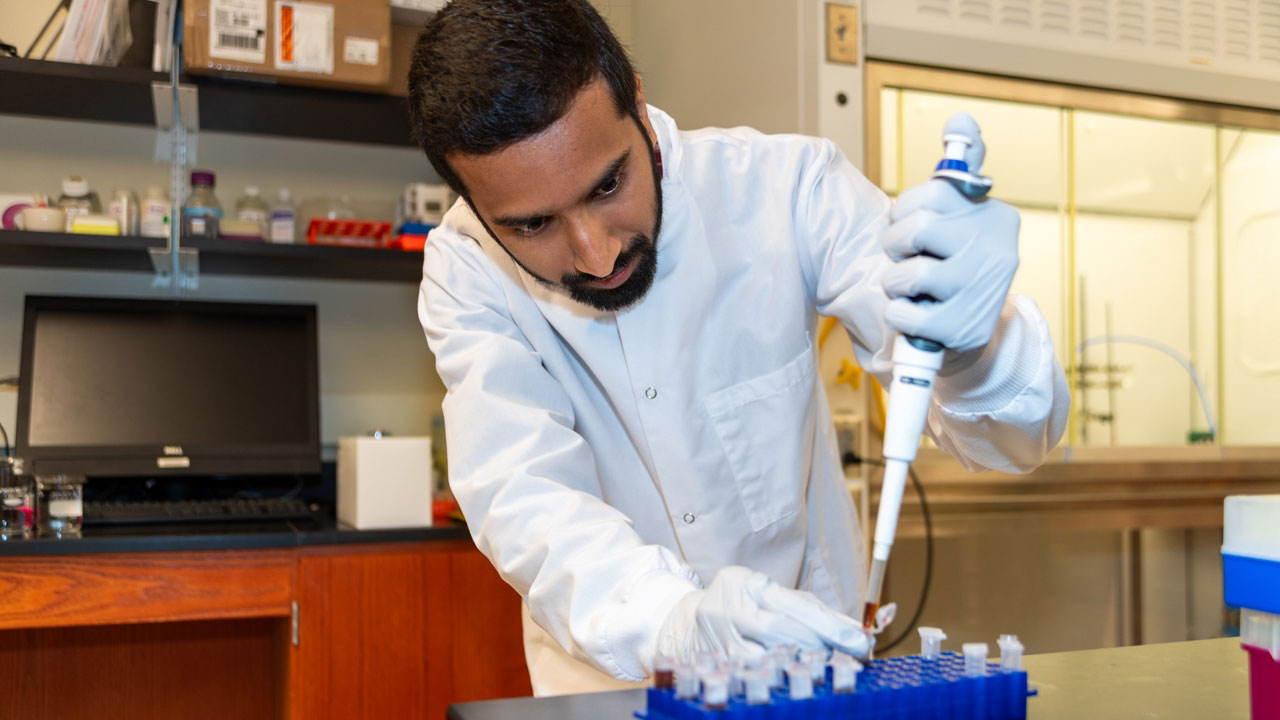Startup with chemical engineering roots awarded $1 million NSF grant to provide MRI clinicians with safer contrast agent
Published: Oct 10, 2023 10:00 AM
By Joe McAdory
What if contrast agents used in magnetic resonance angiographies (MRAs) were toxic-free? What if these injected nanoparticles provided clinicians with enhanced, more comprehensive imaging compared to currently used gadolinium-based contrast agents? They can.
The National Science Foundation (NSF) thought so much of the concept that it awarded four Auburn University scientists a two-year, $1 million grant to continue work on a game-changing idea initially developed in chemical engineering laboratories in 2016 and founded two years later. Housed within Auburn University’s New Venture Accelerator, Nanoxort, LLC is a biomedical startup that aspires to provide clinicians with an iron oxide MRI contrast agent – easier on the body and sharper to the eye – in place of gadolinium.
“Gadolinium can be toxic, and some patients report side effects including headaches and nausea. In rare circumstances, gadolinium has been deposited in the brain, kidneys, and other organs, it is not recommended for patients with poor kidney function and children” said Nanoxort Research and Development Manager Abhinav Sannidhi, principal investigator (PI) on the Small Business Innovation Research (SBIR) Phase II grant-winning project, “Novel size-changing, gadolinium-free contrast agent for magnetic resonance angiography.”

This comes on the heels of Nanoxort’s $256,000 NSF STTR (Small Business Technology Transfer) Phase I grant awarded in 2021.
“Gadolinium is also a cause of nephrogenic systemic fibrosis, a rare disease linked to the contrast agent’s retention in the body,” said Sannidhi, who earned a doctorate in chemical engineering in 2020. “Our contrast agent will not only provide a longer imaging window with much brighter contrast properties for MRI, but it will also leave the body through renal clearance, providing a better safety profile.”
Contrast-enhanced MRAs are pivotal players in diagnostic procedures for potentially detecting early-stage vascular disorders such as atherosclerosis, deep vein thrombosis (DVT), peripheral artery disease, carotid artery disease, pulmonary embolism, cerebrovascular disease, and others.
Allan David, acting associate dean for research and the John W. Brown Professor in chemical engineering, co-founded Nanoxort with then-graduate research assistants Tareq Anani (Nanoxort’s president) and Barry Yeh (Nanoxort’s general manager) knowing there had to be an alternative to gadolinium. Lab studies revealed a technology designed to improve disease diagnosis and reduce the toxicity of MRA/MRI contrast agents.
“This has been an exciting journey,” said David. “As we have progressed from ideation, to identifying an opportunity by interviewing more than 300 radiologists and MRI technicians, to developing an initial prototype, it has been very rewarding to see the growth of this team.
“The next year will be a critical period for Nanoxort as we look to derisk the product and position the company for future growth.”
During the SBIR Phase II grant period, the first year will be focused on the final optimization and selection of the product, conducting advanced in vitro toxicity, pharmacokinetics (PK), and biodistribution studies. The second year is dedicated to the diagnostic efficacy, toxicity studies in rodents and demonstrating the scale-up manufacturing of the final product with the help of industry partners/ subcontractors.
“After the completion of these studies, the company plans to conduct pre-IND safety and toxicity studies as well as clinical studies with the help of additional investments and strategic partnerships with Big Pharma companies,” Sannidhi said.
Already successful among startup pitch competitions, winning more than $56,000 in capital at the Auburn LAUNCH in 2018 and as an Alabama Launchpad finalist both in 2019 and 2021, Nanoxort has its sights set on a bigger prize – going to market. After all, the team applied for a U.S. patent in August 2023 and is awaiting FDA clearance for clinical studies.
“It’s very exciting and fulfilling to solve real-world problems,” Sannidhi said. “I'm glad to be a part of this groundbreaking innovative technology where we not only help patients, but also radiologists, physicians and insurance companies with safer accurate diagnosis and better treatment. Together, we provide valuable safer biomedical imaging solutions that we develop in our lab and commercialize with the help of industry partners.”
Media Contact: , jem0040@auburn.edu, 334.844.3447
Abhinav Sannidhi is Nanoxort's research and development manager and the principal investigator on the Small Business Innovation Research Phase II grant-winning project, “Novel size-changing, gadolinium-free contrast agent for magnetic resonance angiography.”


